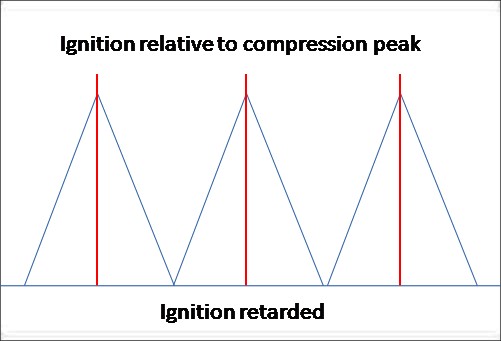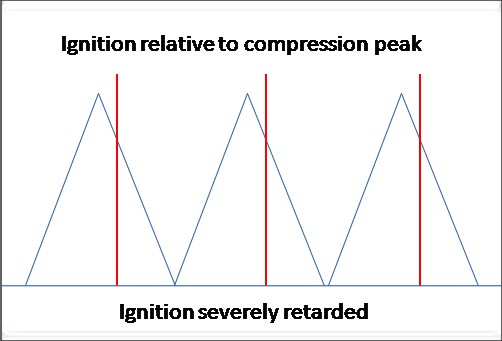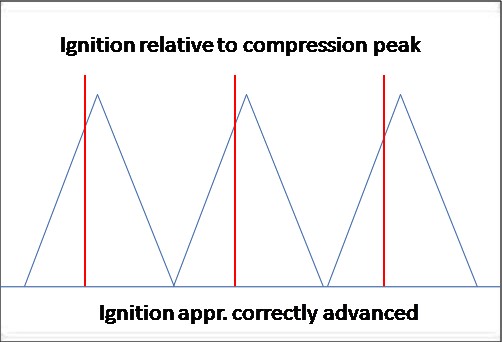
While there is a good chance that younger technicians might recognise a distributor in the above image, there is also a more than even chance that younger technicians will not fully appreciate that many, if not most drivability issues on cars stemmed directly either from defective distributors, or from incorrectly set distributors. In fact, there was a time when checking the distributor and its settings was almost always the first step in diagnosing driveability issues, but since technological advances in engine control systems has removed this option from our diagnostic toolboxes, we have to resort to other measures. In this article, we will take a closer look at how ignition timing settings influence engine performance, as well as why it is important to check ignition timing settings when you encounter some kinds of driveability issues, starting with this question-
The short answer is that even the most advanced distributors cannot alter ignition timing settings fast enough to keep up with modern fuelling strategies. In fact, even distributors using optical sensors suffered from a severe time lag, since the timing advance mechanism on these kinds of distributors depended on engine vacuum to work even halfway properly.
Moreover, with the advent of stringent emissions regulations, engine designers were compelled to improve both ignition and fuel delivery systems to the point where fuel delivery and ignition timing adaptations needed to occur several times per second to keep exhaust emissions within legal limits. Faced with these requirements, engine designers and engineers realised that there is no way they could make a distributor that would respond to changes in engine speed/load fast enough, and starting in about the year 2000 distributors (as we knew them), were abandoned altogether.
Nonetheless, delivering an ignition spark at exactly the right moment is more important now than it has ever been, and to do this, engineers have devised microprocessors to manage ignition timing settings on modern engines. In some ways, these microprocessors can be thought of as highly specialised electronic distributors, but their operating and control systems are so far removed from those of old-style distributors that no meaningful comparisons can be made between them and old-style ignition control systems.
The practical effect of electronically controlled ignition timing is that in most cases, it is impossible to reset base ignition timing settings except with advanced software running on equally advanced diagnostic computers. In fact, modern engines do not even have ignition timing marks anymore, and in many cases, the only way to obtain information on ignition timing settings is to monitor the relevant live data on a suitable scan tool, which begs this question-
The fact is that you often don’t, especially if you have drivability issues like a serious loss of power, rough idling, hard starting, poor fuel economy, and excessive emissions, among others. The problem is though, that issues like these can have causes other than incorrect ignition timing settings, and if you don’t know that defective or incorrectly set old-style distributors caused all of the above, you might be forgiven for thinking that since ignition timing settings on modern engines can generally not be adjusted, ignition timing settings cannot cause these issues.
Consider this scenario however: you are presented with a vehicle that exhibits all of the symptoms listed above, but a diagnostic scan reveals no new fault codes. So, since no new fault codes are stored, where would you begin to trace the root cause(s) of the customer’s concerns? What would your gut feeling tell you? Would you suspect a fuelling issue like excessive fuel pressure, a crankshaft/camshaft correlation issue, or perhaps issues with the variable valve timing control system?
If you think about this situation objectively, the fact that there no codes stored that relate to the systems listed above should tell you something, but as we all know, overlooking the obvious is sometimes very easy. For instance, the absence of trouble codes should tell you that the fuel, crankshaft/camshaft correlation, or variable valve timing systems are not at fault, since failures in these systems almost always set trouble codes. The absence of trouble codes should also tell you to look elsewhere, and a good starting point would be live data under a variety of engine operating conditions.
Therefore, let us look at basic freeze frame data taken when the engine was running at 1 500 RPM. Nothing jumps out at you, but you do notice something weird- the ignition timing is running at 7 degrees BTDC. Therefore, you take another freeze frame, but this time, the ignition timing is shown running at 11 degrees BTDC with the engine running at a steady 2 500 RPM, but it drops to 3 degrees ATDC when you release the throttle. Something is clearly wrong, but since the freeze frame data is not of much help, we need to go back to the basics of ignition timing control, and one way to do that, is to-

This image is a rough approximation of an oscilloscope trace that shows peaks in compression pressure that are 720 degrees apart, while the red vertical lines represent ignition events.
Setting up a scope to obtain an actual trace is easy. Simply connect a current clamp around the battery positive lead, connect an input to an ignition coil output, and crank the engine with the fuel system disabled with a scan tool to prevent the engine starting. The actual trace will be more complex than this rough example, but each compression stroke will load the battery positive lead, and thus produce a compression peak, while the ignition sync will appear relative to the compression peak, which should tell you everything you need to know.
Note though that while the representation above does not match the example mentioned previously, this example and the two following do serve as references that will explain the symptoms described previously.
Consider the image above; since we know that the ignition spark must be delivered before top dead centre, this image shows the ignition spark arriving concurrently with the peak in compression pressure. In practice, this means that the ignition timing is retarded, which explains the power loss, rough idling, and poor fuel economy. Consider the next example trace-

In this example, the ignition spark is shown arriving many degrees after top dead centre. In fact, this example shows the ignition spark arriving when the piston has already begun its downward motion, which explains the hard starting, power loss, rough idling, and extremely poor fuel economy. Now consider the next example-

In this example, the ignition event is shown to the left of the compression pressure peak where it should be, but the key word here is “approximately”. If there is a noticeable loss of power, marginal increase in fuel consumption, and a general sluggish feel to the vehicle, it is possible that the ignition spark is arriving a few degrees too late.
To be sure of this you have to measure the distance between the compression pressure peak and the ignition sync in degrees of crankshaft rotation to arrive at a figure that represents the base ignition timing in degrees before top dead centre. Note though that while using current drawn through the battery positive cable works well enough if you only want to confirm or eliminate incorrect ignition timing settings as the cause of driveability issues, you will need a more accurate method to capture compression peaks in real time if you want to calculate actual ignition timing settings.
The best way of doing this is to use a pressure transducer in the place of a spark plug, since it allows you to generate scope traces while the engine is running. Moreover, ignition syncs made with pressure transducers are more accurate than any other method, and by several orders of magnitude, to boot. Nonetheless, here is-
If you own a high-end scope, the procedure is relatively painless because the scope will calculate the ignition timing automatically. However, you need to give the scope reference that spans 720 degrees, i.e., two successive compression peaks, which you can do simply by dragging a cursor to align with the ignition timing event you want to measure. On these scopes, a box will usually appear that will contain the ignition timing in degrees of crankshaft rotation.
However, if you do not own a high-end scope, you will have to some math yourself. This is not really difficult, so here s a generic method that will work on most scopes-
First, use the cursors to mark out a reference; this will be the distance between two successive compression pressure peaks, and most scopes will display the time lapse between the two peaks in milliseconds. Therefore, if we take an example time lapse of say, 527.2 milliseconds, we need to divide this by 720, to arrive at the rotational speed of the crankshaft in degrees, which in this example is 0.73 milliseconds per degree of crankshaft rotation.
Next, we leave on cursor that marks out a pressure peak, and move the second cursor to the ignition timing sync/trace, which will yield another displayed measurement in milliseconds. If we take an example value for this measurement of say, 29.46 milliseconds, we must divide the crankshaft’s rotational speed per degree, in this case, 0.73milliseconds, into the time-lapse value between the second compression peak and the ignition sync. In this example, the calculation will yield a value of 40, which represents the ignition timing advance or retardation in degrees of crankshaft rotation.
Of course, 40 degrees is an extreme example, but it does illustrate the point that the ignition timing on any engine can be measured accurately. In fact, and regardless of the method you use, any ignition event that occurs to the right of a compression pressure peak (or co-incidental with the peak) indicates that the ignition timing is retarded. Similarly, any ignition event that occurs to the left of a compression peak means that the timing is advanced, which begs this question-
There are admittedly not many things that can cause this, but the fact is that we often overlook at least some possible causes, because for as long as the crankshaft angle sensor and its reluctor ring seem to be in good condition, we are inclined to think that they are in fact, in good condition.
However, issues like worn, damaged, or broken rubber cushions in harmonic balancers can potentially cause the fixed reference point to shift. Thus, while the crankshaft position sensor will still generate ignition trigger signals, the fact that the position of cylinder #1no longer coincides with the fixed reference point on the reluctor ring means that each ignition trigger signal will be generated at the wrong time, thereby either retarding or advancing the ignition timing.
The same thing can happen when the key that indexes a crankshaft pulley on a crankshaft starts to wear because the locking bolt was not torqued down properly. As we know, the key can eat away at either the crankshaft or the pulley, and when this happens, the fixed reference point on a reluctor ring will also shift relative to the position of piston #1, thus affecting the ignition timing.
The problem with these kinds of issues is that they are not always immediately apparent, since a), modern engines do not have timing marks, and b), the tension of serpentine belts tend to mask the symptoms and signs of a wobbling crankshaft pulley, which leaves us with this-
Since it is easy to develop an over reliance on diagnostic computers, we often take the absence of evidence (in the form of trouble codes) of a problem as evidence of the fact that there is no problem.
Moreover, we sometimes also tend to forget that not all causes of drivability issues set trouble codes, which if we think about it, is a valuable diagnostic clue in itself, because ECU’s cannot monitor the condition of things like crankshaft pulley keys and the rubber cushions in harmonic balancers. So the next time you encounter serious driveability issues that do not come with trouble codes, do yourself a favour and take a step back. Consider what it is that makes an engine run efficiently, and plan a diagnostic strategy that focuses on the things that an ECU cannot monitor, control, or adapt, and in nine cases out of every ten, the solution will jump out at you.